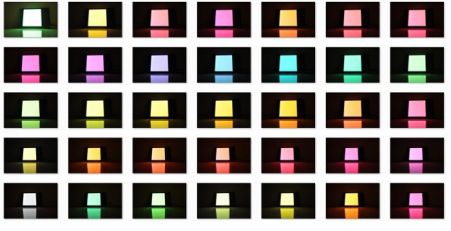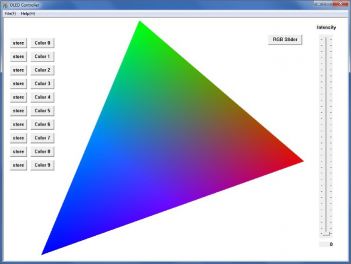Verbatim started shipping the Velve OLED lighting evaluation kit back in May 2011, and last month they sent us a unit for review. This is the world's first (and only) color-tunable OLED lighting panel, and it's pretty exciting.
What's in the box
This OLED evaluation kit contains a power plug, USB cable, control software CD, a user manual and of course the OLED module itself. Unlike Philips, the package is very basic. Unlike most OLED sample kits I reviewed so far, Verbatim's panel is enclosed in a large heavy metal case. Verbatim says that it 'adds value' (and protects the panel) and they got positive feedback, but on the other hand it really misses the point of having a thin light panel. In fact, while the panel itself weighs just 192 grams, the module weights about 700 grams.
In the photo below you can see the module's connectors and buttons: the power and USB plus, and the white, color and dimmer buttons. The white buttons cycles through several white color temperatures. The color buttons cycles through several colors, and finally it shows a nice fluid color changing demo.
About the OLED panel
The OLED panel itself (product number 52800) is 146.4x133.4 mm in size, and 8.7 mm thick. This is actually quite thick comparing to other OLED panels (for example Philip's Lumiblades are less then 2 mm thick). This is because they added the color and tonal controller (PCB) on the back (without the controller the panel is just 3.9 mm thick). The active area of the panel is 123x123 mm. The efficiency is rather good at 31 lm/W, the CRI is over 80, the lifetime is only 8,000 hours (LT70) and the maximum brightness is 1,000 cd/m2. Here's the product brochure.
As I said already, this OLED is color tunable. It uses an RGB strip architecture - which means that there are thin strips of red, green and blue OLEDs. Each color is controlled individually and so you can achieve any color you want. This is actually pretty cool and very useful for showing different white light temperatures (warm, cold, etc.) and also colored light. The OLED is manufactured by Mitsubishui Chemical (Verbatim's parent company) in partnership with Pioneer.
In May 2012 Verbatim announced their 2nd-gen panel which is twice as bright at 2,000 cd/m2, and also comes in several sizes. Those new panels aren't shipping yet, but Verbatim told me that will have the control PCB separated from the panel which will allow great design freedom. The new panels will also feature RYB strips (red, yellow, blue) instead of the current RGB strips.
About the OLED module
It is very nice that you can just take the module, connect the power adapter and immediately show different colors. Using one button you can cycle through different white light colors: two warm-yellow options (2700K, 3000K), two cold-white options (5000K, 6500K). Another button cycles through colors (Red, Green, Blue, Yellow, Magenta and Cyan). One more click on the color-button and you get a very cool automatic gradual-change sequence of colors, moving smoothly though all the colors, showing the intermediate colors. Very nice!
One thing I noticed is that the power adapter is a bit noisy. I'm usually quite sensitive to sounds, so it may not bother everyone. Of course this is just the adapter in the evaluation kit and if you plan to use the panel itself you shouldn't be concerned.

The control software
As I said before, the module includes a USB connector, and you can hook it up to your computer to control the light output (color and intensity). I have to say that the manual is not very clear (and even has some typos), and the installation of the software and the driver itself is very confusing. But actually it's very easy - you connect the USB cable and the driver installs automatically. The software is a compressed file (an LZH archive, of all file types), so you simply uncompress it and launch.

The control software is very basic: you click on a location inside the color-triangle, and the matching color will light on the Velve panel (it's not exactly the same color, though - for example the center of the triangle is white on the OLED panel). You can save up to 10 custom colors (but these get deleted when the software closes). You can also choose the light intensity and use RGB sliders instead of the triangle.
I have to say I was disappointed with the software. I'm sure Verbatim could have done better: it isn't very stable (it crashed a few times during my review), there's not way to save color presets, there's no way to code a sequence and see it on the OLED panel, and the colors on the screens should have been matched to the OLED panel color. These are small issues, but they shouldn't be too difficult to do...
Conclusion
So there you have it - the world's first color tunable OLED. It's quite impressive, and I'm sure designers will love to use such a panel to create ambient and mood lighting installations. Like all OLED lighting panels on the market this isn't ready for commercial use yet (it's too expensive, lasts for a rather short time and it isn't very efficient. But in the (near?) future OLEDs will improve quickly I'm sure.
Verbatim tells us that the kit is almost sold out (they have probably stopped manufacturing them, getting ready to release the 2nd generation panels and kits soon). The kit costs $802.75 and the module costs $752.05.

